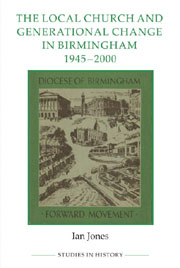Book contents
- Frontmatter
- Contents
- List of figures and tables
- Acknowledgements
- Abbreviations
- Map of Birmingham
- Introduction
- 1 Birmingham: the city and its churches
- 2 The spectre of ‘decline’
- 3 Church, youth and family from the 1940s to the 1960s
- 4 Life and worship in the local congregation
- 5 Church and neighbourhood: four congregational stories
- 6 Towards the margins: being Christian in a pluralist society
- Conclusion
- Appendix: Oral history
- Bibliography
- Index
1 - Birmingham: the city and its churches
Published online by Cambridge University Press: 05 February 2013
- Frontmatter
- Contents
- List of figures and tables
- Acknowledgements
- Abbreviations
- Map of Birmingham
- Introduction
- 1 Birmingham: the city and its churches
- 2 The spectre of ‘decline’
- 3 Church, youth and family from the 1940s to the 1960s
- 4 Life and worship in the local congregation
- 5 Church and neighbourhood: four congregational stories
- 6 Towards the margins: being Christian in a pluralist society
- Conclusion
- Appendix: Oral history
- Bibliography
- Index
Summary
Religion and society in postwar Birmingham
On 7 may 1945 Birmingham citizens breathed a sigh of relief as the war in Europe ended. With the formal announcement expected for some days, the Birmingham Post reported that city-centre crowds received the news ‘without excitement, almost, in fact, in a mood of complacency’. Soon however, flags appeared on civic buildings. Buses and tramcars were prepared for flood-lighting. By evening, the mood became more celebratory: in Victoria Square a group of ‘mainly young people’ sang hymns, whilst nearby in Stephenson Place, others sang ‘the latest popular jazz tunes’. Early on VE Day itself a ‘quiet, Sundayish air’ pervaded. Religious observance was mixed: 4,000 people attended a thanksgiving service in Birmingham's Anglican cathedral, whilst at Aston parish church extra services were hurriedly organised. However, in the south Birmingham suburb of Cotteridge, 39-year-old housewife Betty Foreman remembered only a small congregation for the short VE Day communion at St Agnes, while her husband and neighbour chose instead to celebrate at a local pub. Later, a party atmosphere took hold in many residential districts, with bonfires and dancing to gramophone records in the streets, as if to chase away the shadows of the blackout.
In Birmingham, as nationally, the immediate postwar mood blended celebration, war-weariness, foreboding at the scale of reconstruction ahead and determination to see this through. Whilst escaping the level of destruction suffered by its near-neighbour Coventry, Birmingham's industrial base was nevertheless heavily targeted by bombing – particularly in 1940–1 – resulting in high civilian casualties and extensive damage.
- Type
- Chapter
- Information
- Publisher: Boydell & BrewerPrint publication year: 2012



